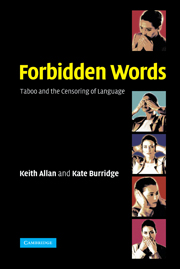Book contents
- Frontmatter
- Contents
- List of figures
- Acknowledgements
- 1 Taboos and their origins
- 2 Sweet talking and offensive language
- 3 Bad language? Jargon, slang, swearing and insult
- 4 The language of political correctness
- 5 Linguistic purism and verbal hygiene
- 6 Taboo, naming and addressing
- 7 Sex and bodily effluvia
- 8 Food and smell
- 9 Disease, death and killing
- 10 Taboo, censoring and the human brain
- Notes
- References
- Index
7 - Sex and bodily effluvia
Published online by Cambridge University Press: 03 December 2009
- Frontmatter
- Contents
- List of figures
- Acknowledgements
- 1 Taboos and their origins
- 2 Sweet talking and offensive language
- 3 Bad language? Jargon, slang, swearing and insult
- 4 The language of political correctness
- 5 Linguistic purism and verbal hygiene
- 6 Taboo, naming and addressing
- 7 Sex and bodily effluvia
- 8 Food and smell
- 9 Disease, death and killing
- 10 Taboo, censoring and the human brain
- Notes
- References
- Index
Summary
This chapter examines the language for sex, gender, sexuality, sexual behaviours, tabooed bodily functions and effluvia from the organs of sex, micturition and defecation (SMD organs). Sexual activity is tabooed as a topic for public display and severely constrained as a topic for discussion. The language of sexual pleasuring and copulation gives rise to a great deal of verbal play and figurative language. Rather curiously for something that is indulged in for fun, as we saw in Chapter 3, it is also a source for terms of heinous insult; this is presumably a hangover from a time when all sex was unholy, except as necessary for procreative purposes between married couples. Our discussion of the language of bodily functions and effluvia makes a special study of the menstruation taboo.
Sex, gender and sexuality
It behoves us to define a few of the categorical terms we use. Sex is anatomical, and most people are born to one or the other sex (though a few are born sexually ambiguous and must be surgically altered to one of the sexes if they are not to remain that way). A person's gender is his/her identity as a certain kind of social being; gender normally coincides with sex, but it does not necessarily do so. People whose gender does not match their sex may choose to become transsexual and be chemically and/or surgically changed.
- Type
- Chapter
- Information
- Forbidden WordsTaboo and the Censoring of Language, pp. 144 - 174Publisher: Cambridge University PressPrint publication year: 2006



